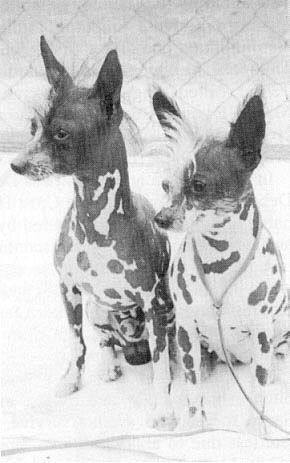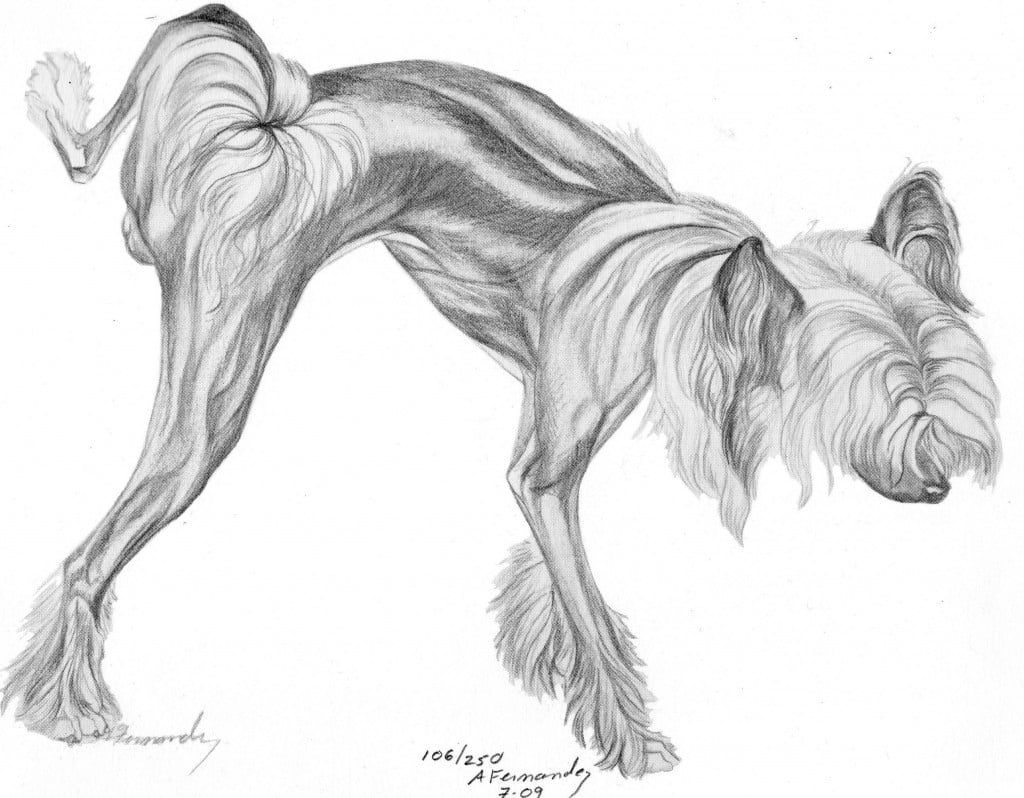About The Breed
History
The Chinese Crested is an old oriental breed, with written history dating back to the 13th century in China. Yet, there is much controversy about exactly where this breed originated as there were hairless dogs found in Africa, Mexico and in Central and South America in the 1500s. So it’s unknown whether the Chinese got the dog from Mexico or brought the dog with them and traded with the Indians of Mexico.
It is thought that the Chinese Crested dog was kept on board the Chinese fishing ships to control vermin, and/or they were a food source. It is also speculated that the hairless dogs were given to Royal Families as they would be content to sit on Elder’s body giving them comfort through the heat that generated from their hairless bodies.
What is known is that the first Chinese Crested dogs were brought to Great Britain as part of a zoological show. The first Chinese Crested was registered in Great Britain in 1881. In 1880, a New Yorker, Ida Garrett, became interested in the breed; exhibiting, breeding and writing about the Chinese Crested for over sixty years. Mrs. Garrett shared her enthusiasm for the breed with a long-time friend Debra Woods. For nearly 40 years the two ladies worked together to promote the breed in the United States. In 1979 the American Chinese Crested Club was founded. In 1991 the breed was recognized by the American Kennel Club (AKC).
The additional promotion of the Chinese Crested worldwide was by the American singer, dancer and entertainer, Gypsy Rose Lee. Her sister rescued a Chinese Crested dog from a Connecticut animal shelter and had given it to Ms. Lee. Ms. Lee was so taken with the breed; she became a breeder and protector of the Chinese Crested. It is to be noted that most active Crested kennels in the world can trace the ancestry of their dogs to the Crest Haven (Debra Woods) and Lee lines. The breed, as we know it, was developed in the late 1950’s and early 1960’s.

Size And Colour
The standard for the breed is 11 to 13 inches at the shoulders, but you will find dogs slightly smaller or larger. Weight will vary depending on the size of the dog. Both types can come in any variation of colours and spots. Not always will an adult be the same colour as when it was a puppy as the coat colour can experience shade changes, this is particularly true of the Powderpuff although the furnishings of the hairless are apt to change too.
Varieties
The breed comes in two coat varieties referred to as the “hairless” and the “powderpuff”. The hairless will only have hair on their head (Crest), feet (Socks) and tail (Plume) with the rest of their body being hairless. However, there can be variations here too. A hairless can be a “Hairy Hairless”, meaning the body can exhibit a short, thin coat covering the entire body, or a “True Hairless”, meaning minimal to no body hair. The powderpuff has hair covering their entire body with a double, straight, soft, silky coat. The face and ears on both varieties can be shaved depending on the preference of the owner.
Temperament
The personality of the breed is to be comical, lively, intelligent and affectionate, with cat-like tendencies (sitting in high places and using their paws to grab). As with all dogs, Cresteds should be well socialized to avoid shyness or fear of the unknown. Their medium to high activity level combined with their outgoing enthusiasm makes them excellent candidates for all types of performance training. They excel at agility, obedience, rally, and lure coursing. Their intelligent and affectionate personalities also make them great therapy dogs.
Grooming
With each variety there is grooming. While the Crested is not the typical “shedding” breed, they will lose hair from breakage and/or during grooming. The hairless may need to be bathed more often to keep the skin clear, using lotions (without lanolin) to keep it supple, and sun block to avoid sun burns on the lighter colored Cresteds. Naturally, extreme temperatures should be taken into consideration with a hairless and clothing (without wool) is something the hairless enjoys. The powderpuff will also need routine bathing and brushing to maintain a healthy coat. Again, avoid products with lanolin as some Cresteds may have a reaction to it. Toy breeds are notorious for having poor teeth, but if you brush your Crested’s teeth regularly you can maintain good dental health. Toenails should be trimmed to a moderate length.
Hypoallergenic
Cresteds are considered hypoallergenic because they have hair not fur. To be “Hypoallergenic” is to have a decreased tendency to cause allergies. There is no such thing as a non-allergenic dog. Hypoallergenic dog breeds will still produce allergens, but because of their coat type will typically produce less than others. People with severe allergies or asthma need to spend time with any breed in order to determine if they will be affected.

